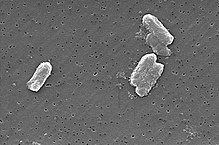Order Enterobacteriales Higher classification Citrobacter | Phylum Proteobacteria Scientific name Citrobacter freundii Rank Species | |
 | ||
Similar Citrobacter, Bacteria, Enterobacter cloacae, Morganella morganii, Klebsiella oxytoca | ||
Best treatment for citrobacter freundii imbalance
Citrobacter freundii is a species of facultative anaerobic gram-negative bacteria of the Enterobacteriaceae family. The bacteria are long bacterial rods with a typical length of 1–5 μm. Most C. freundii cells generally have several flagella used for locomotion, but some do not and are non-motile. C. freundii is a soil organism, but can also be found in water, sewage, food and in the intestinal tracts of animals and humans. The Citrobacter genus was discovered in 1932 by Werkman and Gillen. Cultures of C. freundii were isolated and identified in the same year from soil extracts.
Contents
As an opportunistic pathogen, C. freundii is responsible for a number of significant infections. It is known to be the cause of nosocomial infections of the respiratory tract, urinary tract, blood, and many other normally sterile sites in patients. C. freundii represents about 29% of all opportunistic infections.
Though a pathogen to humans, this infectious microbe in humans plays an important role in the nitrogen cycle in the environment. C. freundii is responsible for reducing nitrate to nitrite in the environment. This conversion is an important and crucial stage in the nitrogen cycle.
C. freundii has also been investigated for biodegradation of tannic acid used in tanneries.
C. freundii has the ability to grow on glycerol, and use it as its sole source of carbon and energy. The organism contains a bacterial microcompartment which is capable of processing propanediol.
